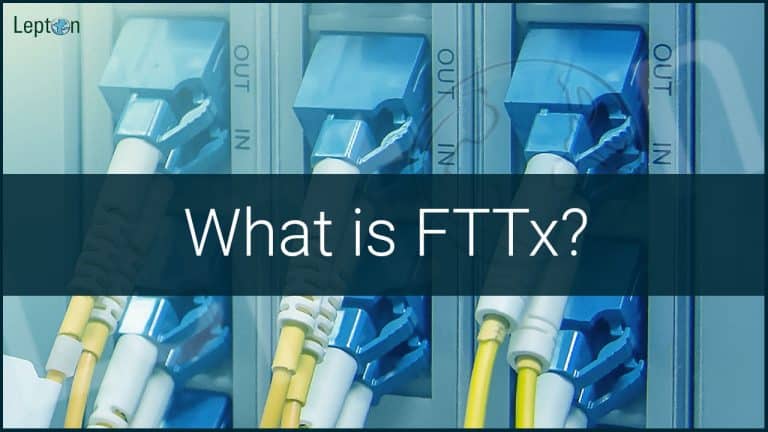
FTTX stands for Fiber to the X (where X is a particular name/object). It is a type of broadband network architecture which uses telecom provider’s network to deliver broadband connections to homes, businesses and other establishments.

Types of FTTX :
FTTH: fiber to the home**
FTTP: fiber to the premises**
FTTC: fiber to the curb
FTTN: Fiber to the node
FTTx: referred to all varieties!
**Fiber to the home or fiber to the premises are the same thing, although “premises” was probably chosen to indicate the user could be a business as well as a household. Anyway, the idea is to bring fiber to the end user and offer high bandwidth services not available otherwise.
FTTH is mostly a telco issue : Telcos have many aging cable plants that cannot support DSL but it is too expensive to replace old copper with new copper just for POTS (plain old telephone service.) However, the aging copper is expensive to maintain. Some analysts also claim that FTTH maintenance costs are so much lower than keeping the current copper network going provides up to 2/3 of the financial benefits of FTTH – much greater than the revenue enhancements!
CATV companies have HFC networks in place and have the ability to bring gigabit signals to the home, although some are looking at replacing the coax drop to the home with fiber.
Competitive carriers now install their own fiber since FCC rules have changed and they cannot be assured of access to competitive carriers cable plants.
Telcos are fighting for exclusive rights where others, such as municipalities or utilities are trying to install FTTH, even if the telcos are not immediately planning on running FTTH themselves.
Besides the telcos, several other groups are attempting to install FTTH.
Municipalities: Some of the first FTTH systems were installed by cities – progressive ones like Palo Alto did it at the request of their high-tech citizens, some did it to entice businesses to move there, like Anaheim, some did it (or are trying to) because they were not pleased with the service of telcos or CATV companies. The latter often found the telcos or CATV companies to be formidable opponents who did not always play fair! Most municipal FTTx projects use rights of way available to the city through city-owned utilities.
Utilities: Owning rights of way to the home convinced some utilities to try FTTH or FTTC. Ethernet over power lines is becoming a option for power companies who can use power lines for the final connection to the home. FTTx is even becoming real for rural customers through rural electrical cooperatives.
CLECs (Competitive Local Exchange Carriers) install their own networks and can then sell connections to anyone they pass, but mostly focus on businesses which spend much more money on communications than households.
Private companies: There are private companies that will build municipal FTTH networks under an agreement with the city, similar to CATV agreements. In addition, some contractors building large subdivisions or apartments are installing FTTH with the assumption that they can connect with telecommunications companies for services to resell.
FTTH is a considered a battleground by telcos and CATV companies: Whenever a city or private company proposes to install FTTH, they can expect to have to deal with the legal, advertising and technical staff of the current telco or CATV company. Cities have found themselves in court or in battles where they are outspent by 100 to 1 in advertising in an attempt by the local telcos and CATV companies to defeat competitive systems.
Where is the bulk of telephone cabling? It may not be where you think!
Only 10% is in long distance networks, which were the first links converted to fiber – years ago. Another 10% is local loop (metropolitan) connecting central offices and switches – now mostly converted to fiber too. Fully 80% of all telco cabling is subscriber loop – the “last mile” that connects the end user to the system.
After 20 years of fiber optic installations, virtually all long distance and local loop connections are already fiber. Only the “last mile” is still copper, and much of it is very old and incapable of carrying modern high bandwidth digital signals. Is FTTx just completing the system to make it all fiber?
Why do we need FTTx? Why do we require it Now?
We recognize five changes in the current telco environment that are affecting attitudes toward FTTH:
- Telcos are losing broadband customers to CATV
- Telcos are losing landline customers to cell phones and VoIP
- New services are becoming available
- Fiber optic components are getting less expensive
- Regulations changed sharing issues
New Technology makes FTTx cheaper – comparable in cost to copper solutions, lower in cost per bandwidth and with lower operating expenses.
Many telcos are realizing that the alternatives to FTTH are inadequate for future bandwidth needs:
- DSL won’t have the bandwidth over most installed copper
- Wireless won’t have the bandwidth, and the spectrum may not be affordable
- BPL (broadband over power lines) won’t have the bandwidth
If the alternatives do not offer the bandwidth, they cannot be cost effective. Many are realizing that eventually they will have to go FTTH, so why put off the inevitable?
Who Wants FTTx?
- Homeowners: for high speed Internet access and video downloads
- Home Builders
- FTTx adds value to their homes
- FTTx provides a reason to provide structured cabling inside the home
- These two reasons can add Rs 5L to Rs 10L to the value of a home!
- Hardware Providers who want to sell equipment to build the networks and install in the homes as well as structured cabling companies who participate in a market that is about $2500 per home!
- Service Providers: IPTV, HDTV, video on demand, etc. Those who want to offer video services are most happy with FTTx as nothing provides the same bandwidth!
FTTx Growth in India
India optical fiber cables (OFC) market is projected to grow at a CAGR of 17% through 2023. Growth in the market is majorly expected to be backed by rising investments in OFC network infrastructure by the Indian government to increase internet penetration across the country, which is in line with the government’s initiatives such as Smart Cities Vision and Digital India. Moreover, growing demand for OFC from IT & telecom sector, rising number of mobile devices, increasing adoption of FTTH (Fiber to the Home) connectivity and surging number of data centers is anticipated to fuel optical fiber cables market in India over the coming years.
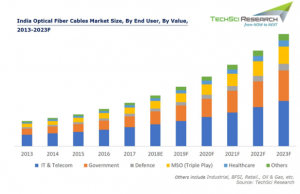

FTTx Cost Breakdown
FTTH Network Design Software is the perfect solutions to save the cost. One estimate by Optical Solutions shows this breakdown on the cost of a FTTH network. Cost decisions are interactive. For example, one wonders if the splitters and WDMs are worth the savings in fiber, but adding more fiber would increase installation and thereby construction costs, so it is assumed that they do indeed save costs. Once cannot overemphasize the importance of labor costs – it is the dominant factor – and anything that reduces labor, like preterminated cabling, deserves consideration.
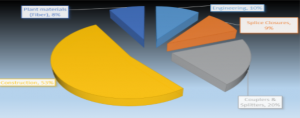
FTTH Architectures
Home run – fiber from CO to every home, offers the most flexibility but at the highest cost as no electronics are shared. A good solution for small developments or rural connections.
Active star – local switch then fiber to every home, highly flexible, but simply moves the electronics closer to the home, saving only a small amount in cabling costs. Think of it as fiber to the curb with the curb to home on fiber too.
Passive optical network (PON) – use splitter near customer share fiber to CO. Not only does it share fiber, it shares electronics, using one transmitter at the CO for up to 32 homes, greatly reducing connection costs. Basic PON architectures are widely used because they are usually the least expensive way of implementing FTTH.
WDM PON – PON but with each customer or location having a specified wavelength. Again highly flexible, but more expensive and harder to manage.
All FTTH networks are based on standard SM fiber(ITU G.652), also called dispersion unshifted or non-dispersion shifted fiber. The only fiber option normally considered is to use low-water vapor fiber that removes the water peak at 1400 nm.
FTTx Architecture Home Run
A home run architecture uses a direct fiber run from the CO to the customer. Each is a full duplex optical link, making this generally more expensive from the standpoint of fiber and electronics requirements. It is used in some small systems, like gated communities, sometimes with 2 fibers, one digital for Internet and VoIP, the other for analog CATV. Some people refer to this as a P2P or point-to-point network.
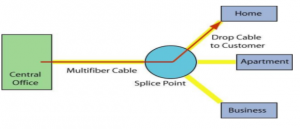
FTTx Architecture Active Star Network
An active star network uses fiber from the central node (CO) to a local active node carrying multiplexed signals to be distributed to all the customers. At the active node, (electronic) switching occurs for each customer and connects to a dedicated optical link to the premises. This may be a more expensive network due to the electronics and powering required, as the node requires uninterruptible local power if support of services like 911 are required, or cheaper for small networks that do not need the size or capability of a PON network. Each system needs to be considered carefully in light of all options.
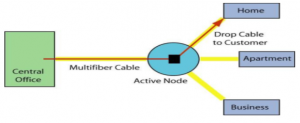
FTTx Architecture Passive Optical Network (PON)
The passive optical network (PON) uses optical couplers, both wavelength division multiplexers and simpler splitter/combiners, to allow connection of many customers over only one fiber from the CO – like broadcasting TV or radio over air waves. Thus a few fibers can support many customers, typically up to 32 customers on one fiber from the CO to the local splitter.
A PON using wavelength division multiplexing (WDM) can be used two ways: It can provide every customer with a dedicated wavelength, greatly expanding bandwidth to any one customer, but a a much greater cost.
A more popular option is to use WDM to send multiple services, usually voice data and video, as well as upstream signals, over a single fiber, as shown in the slides following.
Upstream data from multiple subscribers is time-division multiplexed so each subscriber has a time window to send data back to the system.
Some people refer to this as a P2MP or point-to-multipoint network.
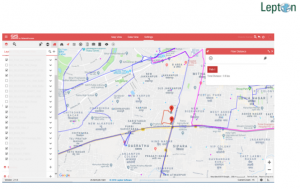
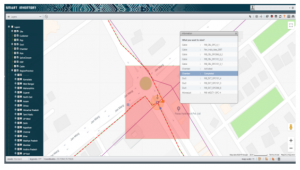


FTTx Alternative Fiber To The Curb
An alternative to FTTH/P is “fiber to the curb.” FTTC brings fiber to the neighborhood and installs a local switch usually in or near a current pedestal. The fiber replaces the copper from the pedestal to the CO, using only the short copper run from the pedestal to the customer premises to make the final connection. Using DSL over these short lengths of copper allows higher bandwidth than a direct CO connection, allowing more flexibility in services offered. A new Ethernet standard for Ethernet in the first mile (802.3ah) is possible for use here with higher capability than current DSL. In addition, if sufficient fibers are installed from the CO to the pedestal at the time of a FTTC upgrade, the system can be converted to a FTTH PON system at a later date by running drop cables to each customer. A new fiber is brought to the pedestal and the CO to pedestal connection is moved to fiber. The subscriber is then connected to the new fiber switch.
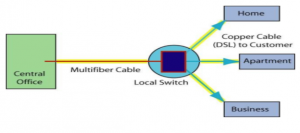
FTTX with GIS
Lepton’s GIS Analytics tool known as Network Access is a platform built to support digitally capturing field data, design of fiber network, network operations, construction supports etc. Services that are provided on this platform such as Quality Analysis/Quality Check, Inventory management, optimize designing of FTTH etc
Planning and designing for planning a FTTH network without GIS had to go through numerous manual steps and dependency on other tools like Auto CAD or traditional methods like drawing, plotting hard copies on paper as shown below:
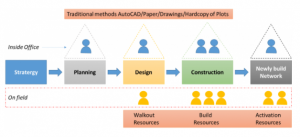
With the use of GIS the entire process becomes consistent with faster processing, higher quality and ubiquitous. It also becomes easy for the office and field employee to perform iterations, change design in case of issues, collaborate data and perform the integration of the system at a massive scale.

Planning and designing with GIS
Below are the steps while planning and designing using GIS tool. Task are divided into 3 types – Manual, GIS enabled and automation.
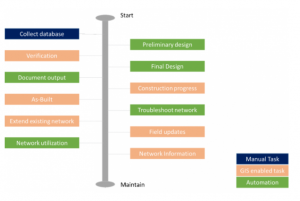
Benefits of using GIS for FTTX :
- Consistent
- Scalable
- Speed
- Quality
- Easy to integrate and collaborate
- Multiple iteration possible in less time frame
- Productivity increases to a very high extent when compared to CAD
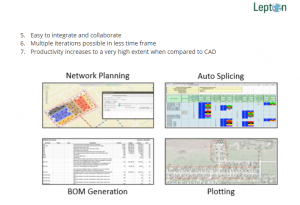 Conclusion :
Conclusion :
Fibre as Critical Infrastructure can really speed up benefits to citizens. To cater to the requirement of the demand of high speed connectivity and to give way for the most talked about technologies such as Internet of Things (IoT), Block-chain, Smart Homes and Autonomous vehicles. Fibre First initiative is, therefore, a most welcome step & the time for action is now.
GIS is the key to success and it will help in planning, designing , intergrating and maintaining the FTTx Network making it more reliable and cost effective solution.[/vc_column_text][/vc_column][/vc_row]
